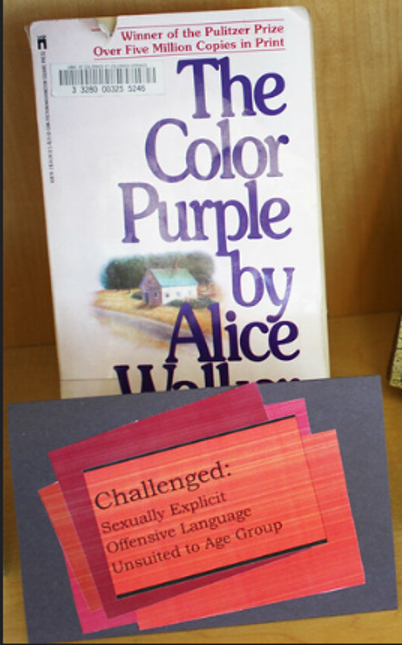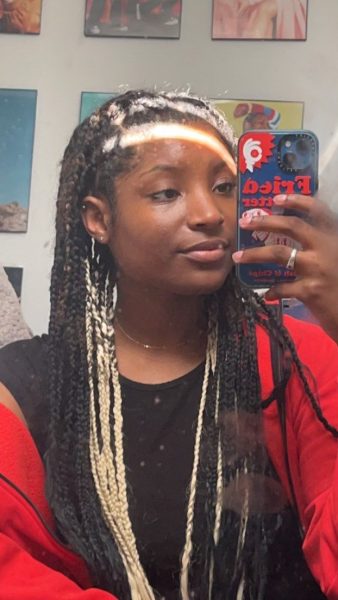Bring Back The Color Purple
(This article is strictly based on opinion).
The Color Purple which was banned in many schools for its explicit descriptions of sexual assault, violence, drug abuse, and explicit language, needs to be brought back for students to read and learn. And here – in my opinion – is why.
The Color Purple has been banned in many, but not all, schools across the country since 1984. While the book does carry some heavy themes and actions, it describes important motifs that all students, regardless of age, would be better off knowing. It is vital for schools to allow this book back into their curriculums. Now, this banning is in no way directed to stop students, or people in general, from reading the book in their own time, for the book is only banned at school, not at home. This is an opinion piece to highlight how students do not have the chance to learn paramount lessons in the place they go to for several hours a day to do exactly that–learn. And one of the many threats to students’ learning is the action of banning books. The list of banned books grows annually, but there is one book I am going to discuss today. – and that is The Color Purple by Alice Walker.
The world we live in today, the world over one hundred years ago. 2022, 1910. Different in numbers, similar in negligence. The Color Purple. A story of how you miss what is right in front of you. The horror of reality. For years, people of color, especially women, have been treated without the slightest pinch of respect. Many stories have been told about this racial inequality, but none are as influential or remarkable as Alice Walker’s The Color Purple.
The Color Purple transcends previous attempts at exploring racial inequality that is happening beneath our very noses. A story about the traumas and gradual triumph of a young girl named Celie, the tale is told entirely through letters. Living in a rural isolated town in Georgia, Celie writes letters to God of her father, Alphonso’s, physical and sexual abuse towards her. She writes to God about the two children she has carried that are both Alphonso’s. She writes to God about how she can scarcely rely on anyone. The one person Celie can rely on, and trust is her younger sister, Nettie. When a man known only as Mr. comes to town and makes his affection towards Nettie overt, Alphonso refuses at once, not bearing to part with his only attractive offspring. To ease Mr.’s wrath, Alphonso makes him go off with Celie, offering the “ugly” sister as a bride. Mr. accepts and leads Celie into an anything-but-enjoyable marriage. Missing her sister terribly, Nettie flees Alphonso and rushes to where her sister resides. When reaching Celie’s house, Mr. makes his still present desires towards Nettie obvious and tries to gain her favor, in a much less glorious way than you would imagine. Naturally repulsed, Nettie runs away, no one knows where to, not even Celie, who, having never heard from her beloved sister again, presumes Nettie is dead.
As the story goes on, further discrimination is made toward Celie – discrimination bout her race, and eventually, her sexuality, which is questioned by Celie herself when Mr.’s lover, Shug Avery, makes an unforgettable impression on Celie. While the story is not a positive one of any sort, there is much that can be taken from it.
Daily, people forget how well life has worked out for them. Every day, people forget how fortunate they are to have families who may not love them unconditionally but do not take advantage of them in any way. Daily, people forget how difficult it is for people of color to make it through the day without being discriminated against. As mentioned before, it happens under our very noses. “I definitely realize how fortunate I am now,” recalls Ridgeway Porritt, a student at Huntingtown High School who has read The Color Purple. “Knowing I’ve never had to go through anything described in this book enabled me to realize how much I take for granted.” Whether it is not being able to use the same bathroom as someone, or not being addressed by someone, people of color are too often treated like dust under a rug. A rug of reality. A rug that has not been swept in years.
It is vital for us to realize that we are all human. And although respect is more promptly earned than given, everyone deserves to be treated with it. The color of someone’s skin does not determine their worth. The color of someone’s skin does not mean you may treat them as you wish. The color of someone’s skin should no longer represent what it did hundreds of years ago, just as it should not have back then. If we allow people of color to continue to be treated with disadvantage and disrespect, we run the risk of never allowing them to accomplish fulfillment and independence. A life lived without equality is not a life. That is a curse. And we are all so used to the life we live today that we do not realize how extraordinary it is. We have lived it for so long, we are accustomed to getting whatever we want. We are accustomed to being able to sit where we want, eat where we want, drive where we want, and be where we want. If that were taken away from us, we learn the hard way something we should have known all along.
When viewing society in action, we do not often consider what is going wrong for others. We too frequently feel that we only need to consider what is going right for ourselves. This is not only selfish, but arrogant, and dangerous to limits unmeasured. It is time we look around and view what others take in daily. It is time we pull ourselves out of the bubble and observe! Looking at the people next to you, you have no idea what they could be going through. The least we can do is understand that we may never understand, and while that is unfortunate in the case of support, it is also okay. We just need to come to terms with it. As The Color Purple constantly reminds us, the resistance of the oppressor through reconciling and exploring all aspects of one’s identity, is not something easily done or done intermittently. As the astute and spirited Celie says, “I am poor, Black, I may even be ugly, but dear God, I am here! I am here!” And it is this that we must take into consideration. Human does not mean skin color. Human does not mean attractive. Human does not mean rich. Human means flesh, blood, and bone. As humans, we are one. Humans are what we are. It is time we started acting like it.
The themes discussed in The Color Purple are racism, gender inequality, suffrage, and self-discovery. As a banned book, The Color Purple is not read and taught at many schools throughout the country. Every day, students miss out on pivotal teachings they would be better off with. When learning about issues such as racism and inequality, students can come to realize how often those issues are presented today. In a world where The Color Purple is not banned from schools, students would have the choice of reading it. Students, while choosing to opt out, could have the opportunity to attain information truly circling the injustice shown towards women of different ethnicities one hundred years ago. Students will also conclude that, although the year numbers have changed, actions have not.





